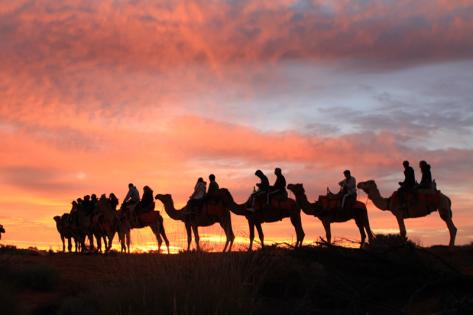It's 4.30am and still dark, and as I walk past the quiet hotel rooms that face onto the pool area I notice one of my colleagues sitting outside his room enjoying the peace of pre-dawn.
I think he must be another early riser, having a solo moment before heading off on a sunrise tour of Uluru.
And then later, when I hear about the partying that went on the night before, I realise he never made it to bed at all.
I'm at Uluru for the launch of the Indigenous free-to-air station NITV, now part of SBS.
And some pretty heavy celebrations continued after the sunset concert the TV station held for the local community.
Am I the only mad person to have gone to bed relatively early, and - for perhaps the first time in my life foregoing a chance for a drink - so I could wake up for my camel ride?
Yes, I think so.
But despite my bleary eyes, it is all worth it when perched on top of my camel I watch the sky, Uluru and Kata Tjuta turn unimaginable colours and the light make photography almost perfect - before the mid-summer heat hits.
It's strangely tranquil watching all this from atop a camel, with only the voice of our guide, Brent Carraill, telling us everything you would ever need to know about our trusty steeds and the local flora and fauna as we ride through the red sand dunes.
Carraill was an accountant before coming out here for a complete change of scene and never ties of the scenery.
Despite there being around a million wild camels in Australia, with at least 700,000 in Central Australia, the owner of this camel farm started with only five camels, brought in from the desert. They now have around 45, some of whom are used for their sunrise and sunset, 10.30am and in cooler months 2.30pm tours.
All have names including one called Oprah after you-know-who, who visited here as part of her big Aussie tour, but apparently this camel didn't take a shine to her.
Back at the quirky museum and souvenir shop, over a breakfast of homemade beer bread, we learn more of the history of camels and the Afghan cameleers who brought them here in the mid 19th century to carry supplies, mail and water to remote settlements and for the overland telegraph and railway line when horses and oxen couldn't.
The camel tours are one of many offered by Voyages Ayers Rock Resort at Yulara, which was bought by the Indigenous Land Corporation (ILC) in 2010 along with the airport, a camping ground, four hotels and an apartment complex, for $300 million.
Voyages Indigenous Tourism Australia, a wholly-owned subsidiary of the ILC, manages the resort on its behalf.
Sails in the Desert, the five-star hotel here which was pretty tired before, has recently undergone a $30 million refurbishment, including Indigenous designs in the rooms' furnishings, art in the foyer, and a modern conference centre, the Uluru Meeting Place.
The huge challenge has been to get people to stay longer than the usual one night, even if only for an extra day, at Uluru. To do this the ILC acknowledged they needed to create a different and more varied experience.
The single biggest complaint by international tourists was they didn't have the opportunity for a genuine Indigenous experience and there were almost no Indigenous people employed at Yulara before the sale.
Now there are all sorts of alternatives to climbing the rock as well as, of course, just walking around it, which actually is one of the most enjoyable activities you can do while here.
They include free daily activities such as hearing bush yarns and diggeridoo playing, seeing spear and boomerang throwing, going on guided garden walks and watching the Wakagetti Cultural Dancers perform. These are held around the Town Square area.
But one of the best things about staying here now are the 170 Indigenous trainees who work at the resort in all areas from waitressing to bar-tending to reception.
Their one-year course is at the national Indigenous training academy based at Uluru which gives them a Certificate III in hospitality management.
The ILC's vision when starting this program in October 2011 was to build up to 200 indigenous trainees a year and by 2018 to have half the employees at the resort Aboriginal.
Every graduate is guaranteed a job, with 35% of trainees from the local community.
For the ones who have come from other parts, many have never left home before so being out here is a big challenge. Older women from the local community, however, do whatever they can to support and help them.
One trainee, Luke, who is our host at our Sounds of Silence dinner, when we're given a "tour" of the night sky, is so exuberant with enthusiasm about being here that everybody who meets him can't stop smiling.
As a spokeswoman for the resort says, "We were behind the eight ball in Indigenous tourism. We're now at the cutting edge of it. We're at a new age of cultural tourism."
If you go:
- Qantas has direct flights to Uluru from Sydney and Melbourne
- Ayers Rock Resort
- Uluru Camel Tours cost between $75 and $119 per person depending what time of day
Note: The writer was a guest of Voyages Ayers Rock Resort for the camel tour.

















__small.png)










